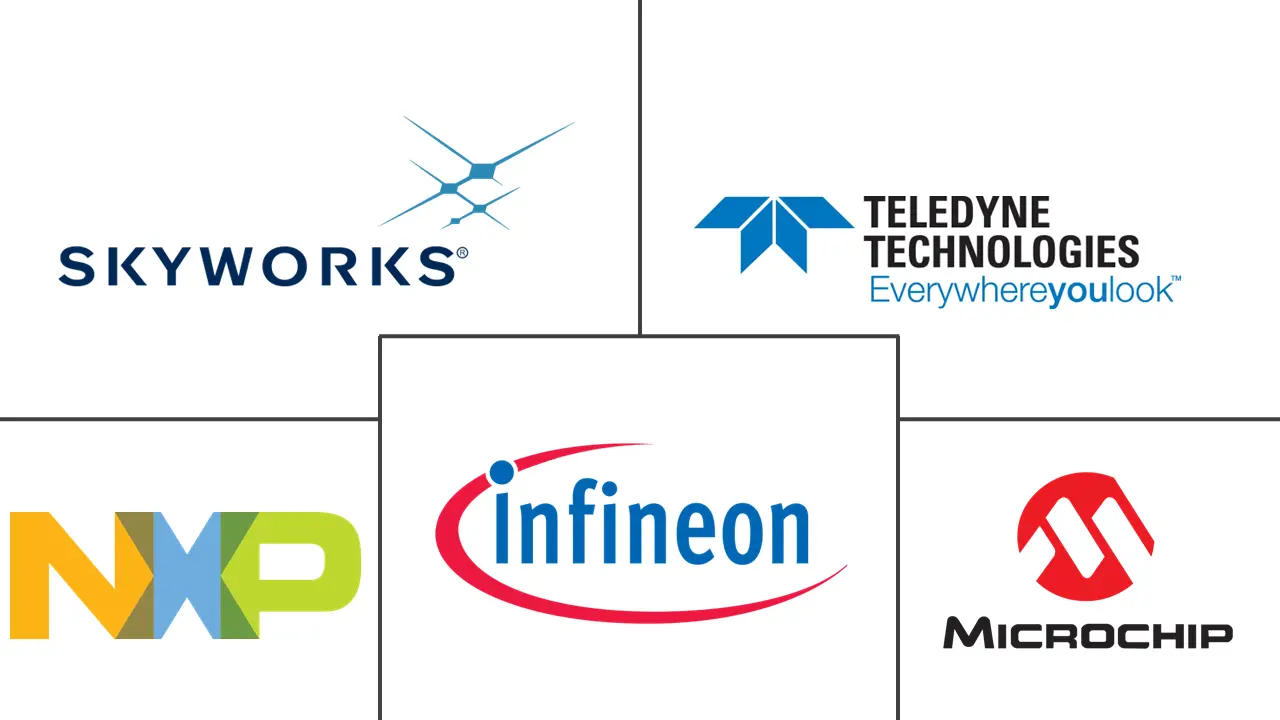Size and Share of Europe Semiconductor Device Market In Aerospace & Defense Industry
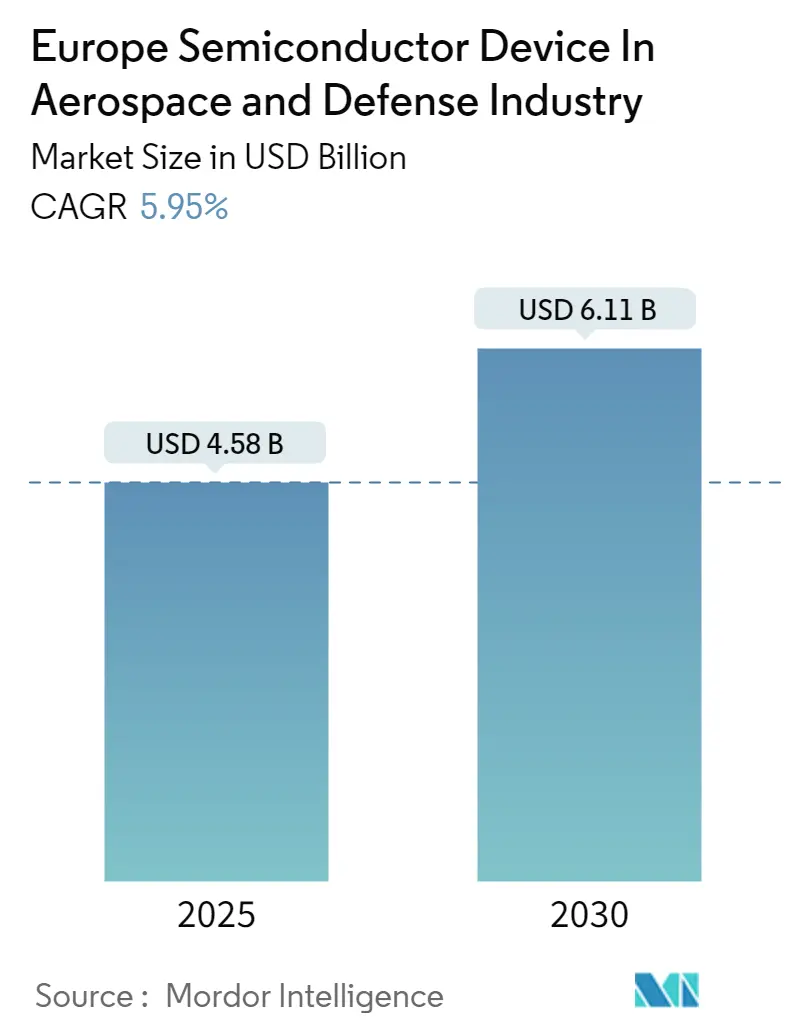
Analysis of Europe Semiconductor Device Market In Aerospace & Defense Industry by Mordor Intelligence
The Europe Semiconductor Device In Aerospace & Defense Industry is expected to grow from USD 4.58 billion in 2025 to USD 6.11 billion by 2030, at a CAGR of 5.95% during the forecast period (2025-2030).
- With increased military spending in Europe on developing the defense sector, there are plenty of opportunities for semiconductor device growth within the European defense and aerospace market.
- Semiconductors are utilized to produce a wide range of equipment and systems in the military and aerospace industries. As power electronics are widely used in aerospace and defense applications, such as power drive controls, landing gear and defensive aids systems (DAS), engine systems and controls, flight control, navigation, cabin lighting, avionics, and communications, there is a significant demand for power semiconductor devices in this industry.
- Europe aims to achieve strategic autonomy by 2033, according to the 2023 Global Strategy. As a result, the European Union (EU) countries have started a complex modernization program to increase their military strength. As a result, European countries are making significant investments in modernizing aerial capabilities to deal with a changing threat environment in the area fueled by geopolitical crises.
- However, the complexity of threats to global security has increased, and it is anticipated that the COVID-19 pandemic's economic fallout will force governments to make difficult decisions about their defense budgets that will significantly impact their short- and long-term military capabilities.
- Furthermore, Microchip Technology, working with European Commission consortium member Clean Sky, developed a family of SiC-based power modules for aerospace applications to enable more efficient and compact power conversion and engine drive systems. The modules use a mix of 1200V silicon carbide (SiC) MOSFETs and 1600V diodes on a modified substrate for harsh aviation applications.
- The importance of space as a market that can present opportunities for both developed and emerging countries has increased during the past ten years. Due to their ability to address global issues like the climate and biodiversity crises and the rising reliance of the EU economy and society on space infrastructure, services, and data, space policies and their applications have also risen in political prominence.
- To protect EU spatial ecosystems and maintain EU autonomy in space, EU space policy has two main objectives: to foster scientific and industrial competitiveness and to increasingly use space investments and services to address important EU political priorities like the European Green Deal and the Digital Decade. These emerging trends will propel the market growth during the forecast period.
Insights and Trends of Europe Semiconductor Device Market In Aerospace & Defense Industry
Sensors Segment to Grow Significantly
- Wireless sensors are a crucial component becoming increasingly important in the defense and aerospace industry. Wireless sensors are a critical semiconductor technology product. When developing military vehicles, their influence on the aircraft's structural integrity, diagnostic optimization, and ongoing health checks continues to be vital.
- Sensors aid in better aircraft control through sophisticated modeling techniques, resulting in lightweight design for more excellent weight performance. These sensors help deliver accurate information on different aspects to increase the vehicle's efficacy and efficiency. 'Smart Skin Technology' has also recently been used in the aerospace sector.
- The revolutionary system equips the exterior of the aircraft body with over 10,000 microsensors, allowing the pilot to keep an eye on the vehicle's condition. It assists in measuring wind speed, temperature, and physical strain movement, enhancing the aircraft's lifespan significantly.
- Military aircraft are built with long-lasting materials that can resist a variety of tasks far beyond the requirements of a commercial trip. This implies that increased g-forces, vibration levels, and dynamic operating maneuvers put an airplane under much stress. However, fixed and rotary-wing aircraft employ aerospace pressure sensors to monitor pressure.
- The Government of European countries is spending heavily on aircraft upgradation and modernization, where sensors will be utilized in a broader way, which will help provide accurate data regarding the temperature and pressure of the cabin, controlling the wings and flaps, and others. For instance, according to SIPRI, in 2022, the government invested USD 345 billion and USD 135 billion in central & western, and eastern Europe, respectively, which will help to create ample opportunities for growing in the studied market.
- Furthermore, to develop highly advanced electronic components for next-generation infrared (IR) sensors and to bolster the supply chain of these cutting-edge goods in Europe, Lynred, a leading global supplier of high-quality infrared detectors for aerospace and defense, has launched HEROIC. This is a consortium of ten European partners led by Lynred, a four-year project with an estimated budget of EUR 19 million (USD 19.8 million), of which the European Defense Fund will contribute EUR 18 million (USD 18.8 million).
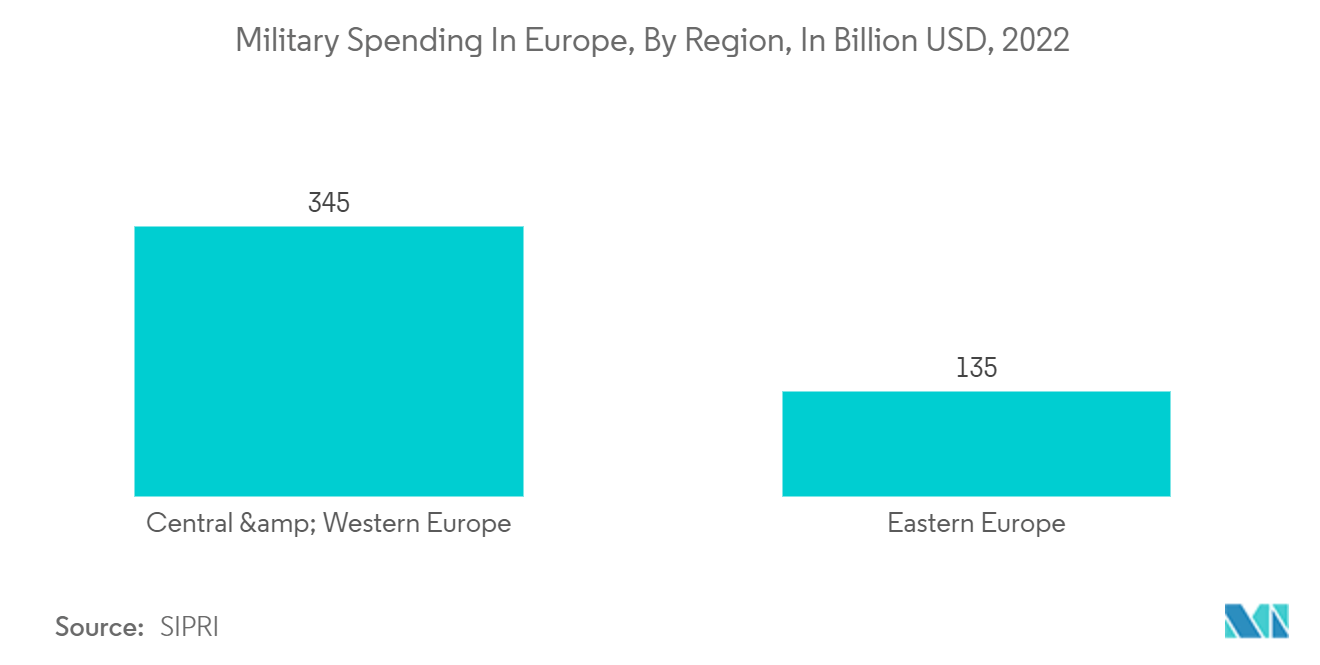
The United Kingdom to witness the significant growth
- The aerospace industry is potentially at a turning point. The United Kingdom's current design, development, and manufacturing skills are threatened by growing market globalization, rising development costs, and the need for plans for new manned fast jet aircraft designs. This will necessitate a significant change in culture and functioning methods, substantially transforming businesses and the government.
- The United Kingdom considers how human-crewed and uncrewed aerial vehicles should coexist as crucial to future combat air capabilities. Due to this, future purchases of unmanned and manned platforms are anticipated, even though there is no need for a new-design human-crewed aircraft beyond what is already planned.
- However, given that human-crewed aircraft are expected to have a service life of at least 30 years, there is a constant need to sustain and modernize both present and future fleets. Moreover, it will be vital to maintain several onshore capabilities to maintain the UK's capacity to undertake operations without becoming overly dependent on other countries.
- According to SIPRI, in 2022, the United Kingdom spent USD 68.5 billion on the military, equivalent to 2.2% of the UK's GDP. This expenditure was 3.7% higher than in 2021; compared to 2013, the increase was 9.7%. This growing government investment in the defense industry will fulfill the required demand.
- The major market players also collaborate and develop innovative products to maintain their market share. For instance, in September 2022, As a part of the United Kingdom's Weapons Sector Research Framework (WSRF), Collins Aerospace was given a multimillion-pound program to create a navigation-grade Inertial Measurement Unit (IMU) for use in upcoming sophisticated weapon platforms. Collins will work with the United Kingdom's Ministry of Defense (MOD) to enhance its projects by utilizing its sector-leading knowledge to create a tactical grade or "Class A" IMU using Micro-Electro-Mechanical Systems (MEMS) technology.
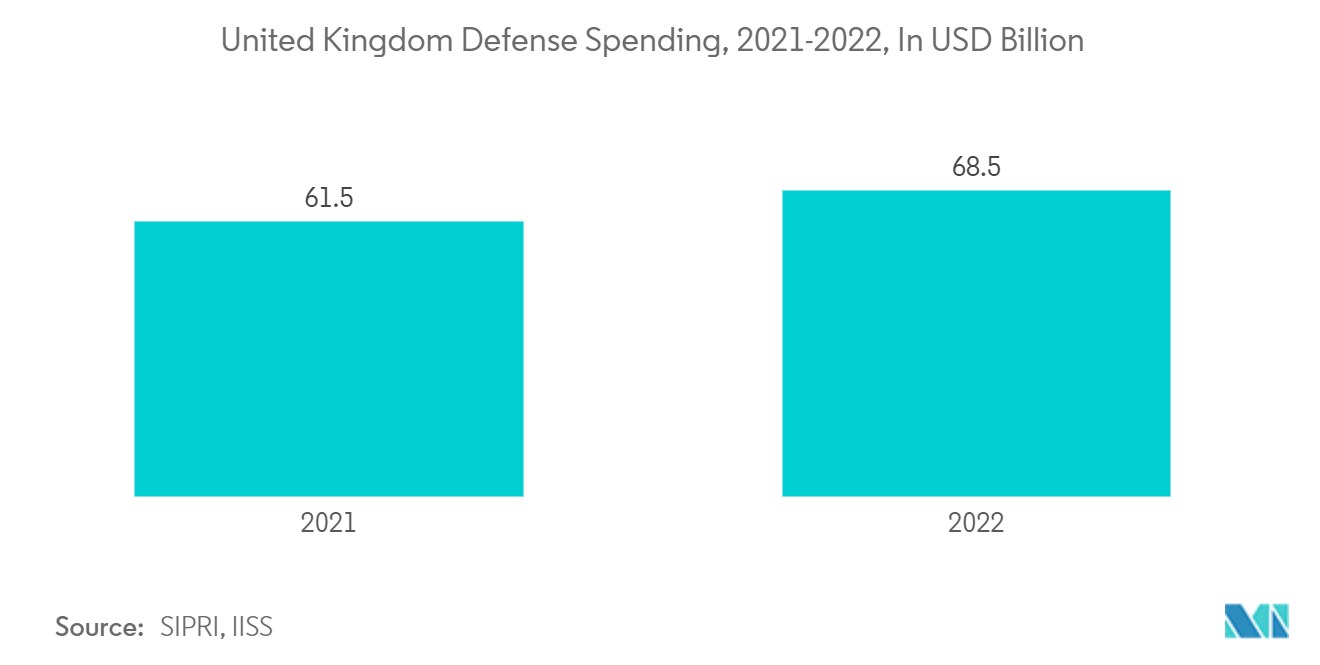
Competitive Landscape
The security landscape is rapidly changing due to increasing geopolitical tensions in various nations, driving a heightened demand for cutting-edge aircraft, UAVs, and satellites. Key players are making substantial investments in the research and development of intricate product offerings, aiming to secure long-term contracts and strengthen their market dominance. Ongoing research and development efforts in the European aerospace and defense industry have significantly benefited platforms and related products and solutions. The market exhibits a moderate degree of fragmentation, with numerous international companies, including Microchip Technology Corporation, NXP Semiconductors, Infineon Technologies AG, Teledyne Technologies, and Skyworks Solutions Inc., among others.
In June 2023, Airbus and STMicroelectronics entered into a cooperative agreement to advance research and development in power electronics. This collaboration is geared towards developing more efficient and lightweight electrical systems needed for future hybrid aircraft and urban air mobility vehicles. The partnership builds on the previous evaluations conducted by both companies regarding the advantages of large bandgap semiconductor materials for electrifying aircraft.
In January 2023, Microchip Technology Inc. expanded its already extensive portfolio of radiation-tolerant products by introducing the MIC69303RT 3A Low-Dropout (LDO) Voltage Regulator. This marks the company's first commercially available (COTS) radiation-tolerant power device. The MIC69303RT, designed for high current and low voltage, serves as a power management solution specifically tailored for Low Earth Orbit (LEO) and other space applications. To meet the requirements of various missions, the device is available for prototype sampling in both plastic and hermetic ceramic forms.
Leaders of Europe Semiconductor Device Market In Aerospace & Defense Industry
-
Skyworks Solutions Inc.
-
NXP Semiconductors
-
Infineon Technologies AG
-
Teledyne Technologies
-
Microchip Technology Corporation
- *Disclaimer: Major Players sorted in no particular order
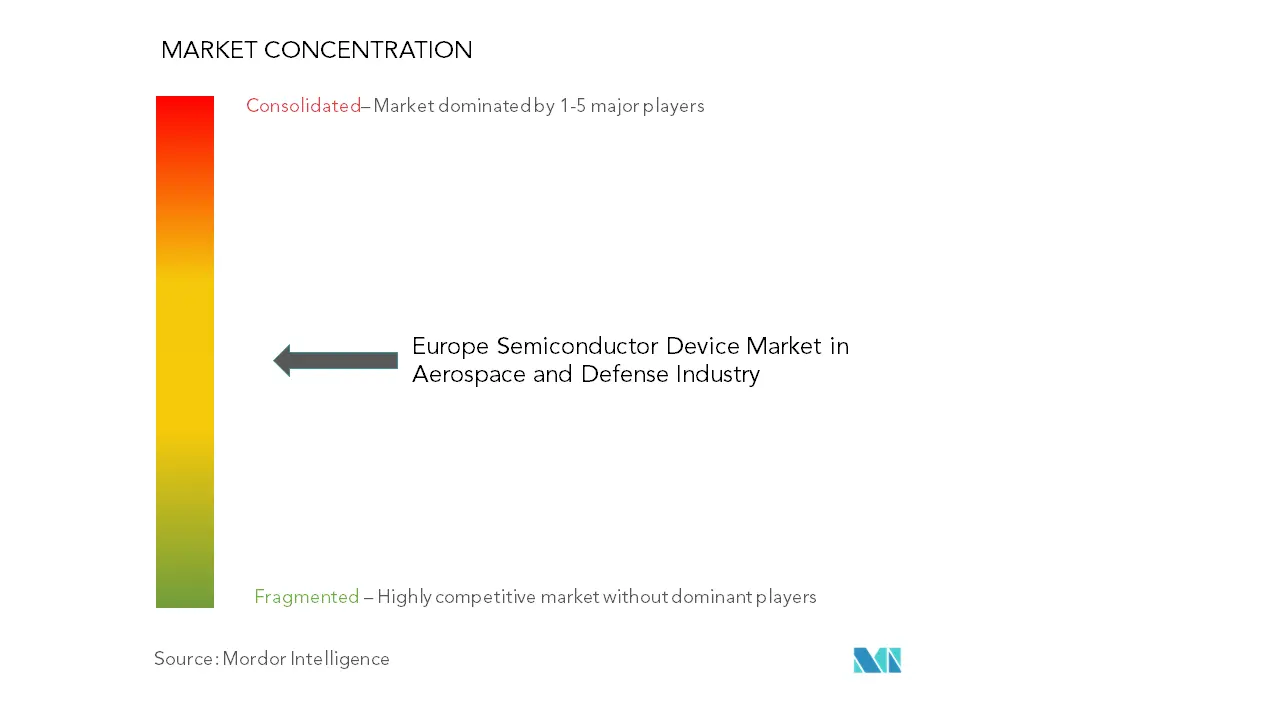
Recent Industry Developments
- March 2023: NI (National Instruments) revealed the acquisition of SET GmbH, renowned experts in aerospace and defense test systems development, and recent pioneers in electrical reliability testing for semiconductors. This strategic move aims to expedite the introduction of critical, uniquely advanced solutions and promote the integration of power electronic materials like silicon carbide (SiC) and gallium nitride (GaN) across the semiconductor-to-transportation supply chain, ultimately reducing time to market.
- February 2023: The United Kingdom government unveiled a new funding round within the Aerospace Technology Institute (ATI) program, targeting the development of electric and hydrogen-powered aircraft utilizing various semiconductor devices. Under this initiative, Vertical Aerospace and Rolls-Royce, key players in eVTOL aircraft development, have been awarded the entire GBP 113.6 million (USD 136 million) budget. This financial support was jointly announced by the Departments of Business and Transport, emphasizing the government's commitment to advancing aerospace technology.
Scope of Report on Europe Semiconductor Device Market In Aerospace & Defense Industry
A substance that possesses properties halfway between an insulator and a conductor is considered a semiconductor. Electronic components, including integrated circuits, transistors, and diodes, are made from semiconductors. Semiconductor components are used in various defense applications, including uncrewed aerial vehicles, missile systems, electronic surveillance and countermeasures, and communication devices.
The European semiconductor device market in the aerospace and defense industry is segmented by device type, including discrete semiconductors, optoelectronics, sensors, integrated circuits (analog, logic, memory, microprocessors, microcontrollers, digital signal processors), and by country, with a focus on the UK, Germany, France, and the rest of Europe.
The market sizes and forecasts are provided in terms of value in USD for all the above segments.
| Discrete Semiconductors | ||
| Optoelectronics | ||
| Sensors | ||
| Integrated Circuits | Analog | |
| Logic | ||
| Memory | ||
| Micro | Microprocessor | |
| Microcontroller | ||
| Digital Signal Processors | ||
| United Kingdom |
| Germany |
| France |
| Rest of Europe |
| Device Type | Discrete Semiconductors | ||
| Optoelectronics | |||
| Sensors | |||
| Integrated Circuits | Analog | ||
| Logic | |||
| Memory | |||
| Micro | Microprocessor | ||
| Microcontroller | |||
| Digital Signal Processors | |||
| Country | United Kingdom | ||
| Germany | |||
| France | |||
| Rest of Europe | |||
Key Questions Answered in the Report
How big is the Europe Semiconductor Device In Aerospace & Defense Industry?
The Europe Semiconductor Device In Aerospace & Defense Industry size is expected to reach USD 4.58 billion in 2025 and grow at a CAGR of 5.95% to reach USD 6.11 billion by 2030.
What is the current Europe Semiconductor Device In Aerospace & Defense Industry size?
In 2025, the Europe Semiconductor Device In Aerospace & Defense Industry size is expected to reach USD 4.58 billion.
Who are the key players in Europe Semiconductor Device In Aerospace & Defense Industry?
Skyworks Solutions Inc., NXP Semiconductors, Infineon Technologies AG, Teledyne Technologies and Microchip Technology Corporation are the major companies operating in the Europe Semiconductor Device In Aerospace & Defense Industry.
What years does this Europe Semiconductor Device In Aerospace & Defense Industry cover, and what was the market size in 2024?
In 2024, the Europe Semiconductor Device In Aerospace & Defense Industry size was estimated at USD 4.31 billion. The report covers the Europe Semiconductor Device In Aerospace & Defense Industry historical market size for years: 2019, 2020, 2021, 2022, 2023 and 2024. The report also forecasts the Europe Semiconductor Device In Aerospace & Defense Industry size for years: 2025, 2026, 2027, 2028, 2029 and 2030.
Page last updated on:
Report on Europe Semiconductor Device Market In Aerospace & Defense Industry
Statistics for the 2025 Europe Semiconductor Device In Aerospace & Defense Industry market share, size and revenue growth rate, created by Mordor Intelligence™ Industry Reports. Europe Semiconductor Device In Aerospace & Defense Industry analysis includes a market forecast outlook for 2025 to 2030 and historical overview. Get a sample of this industry analysis as a free report PDF download.
